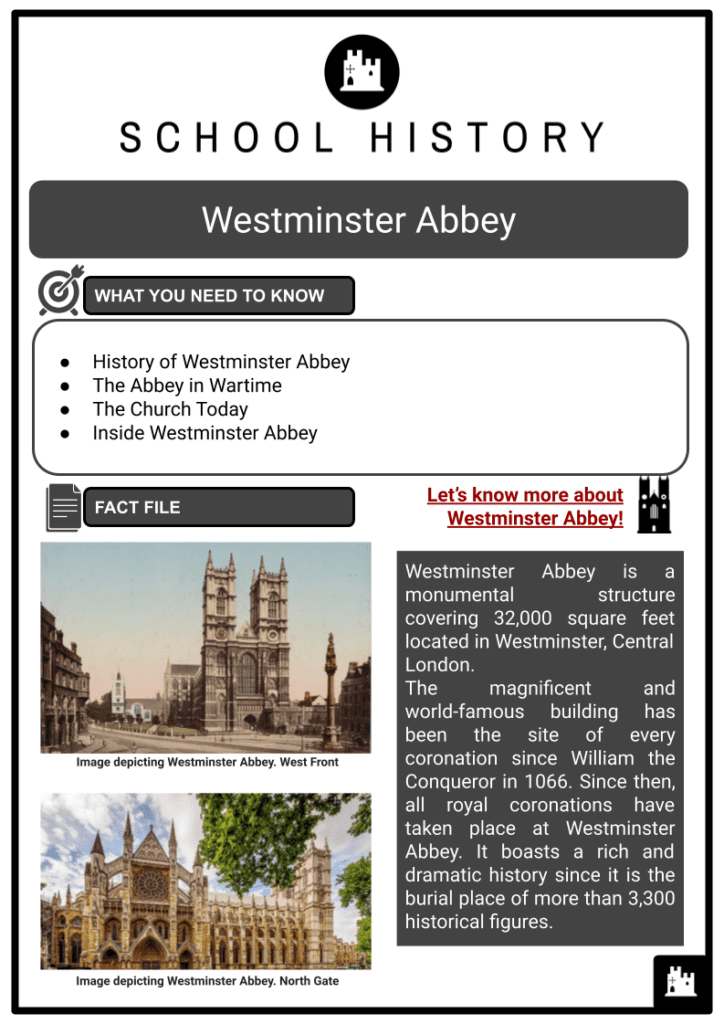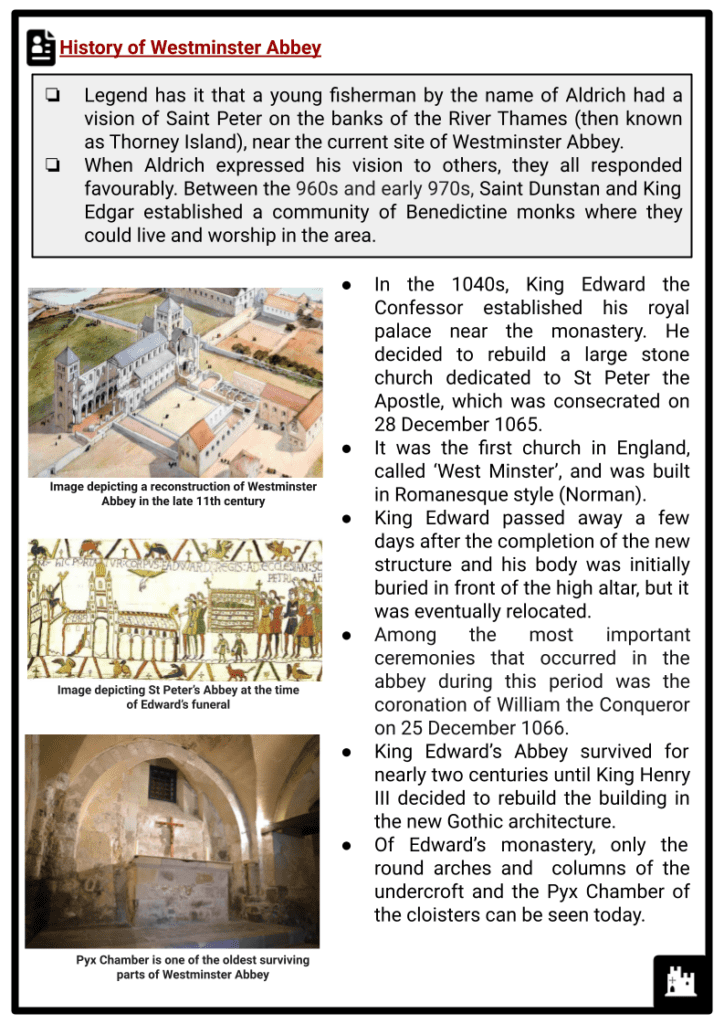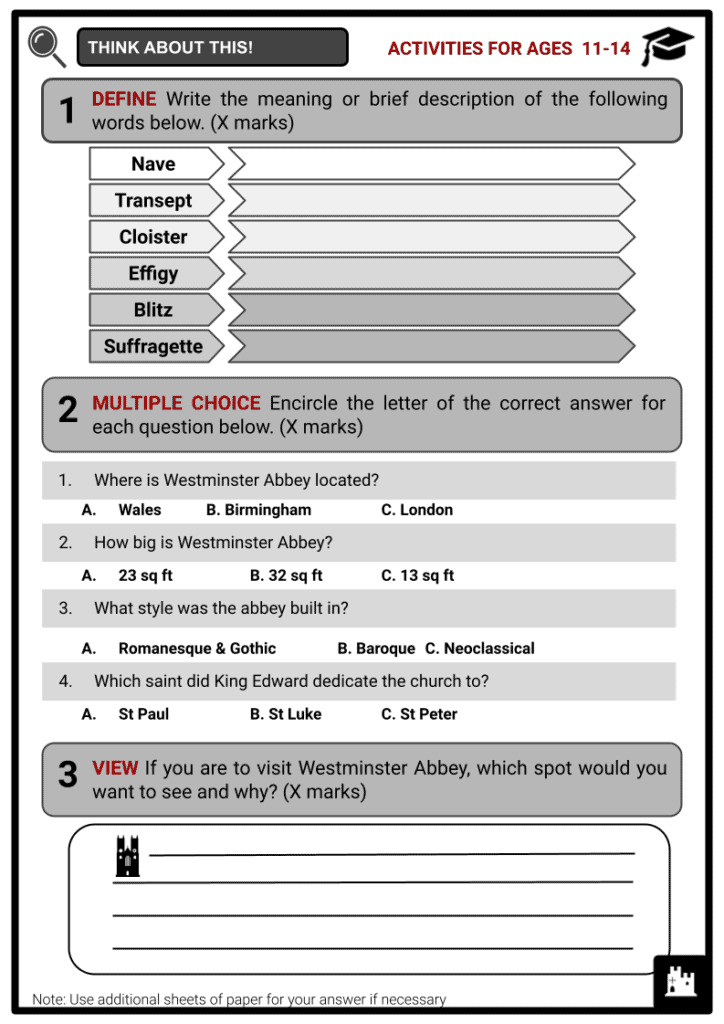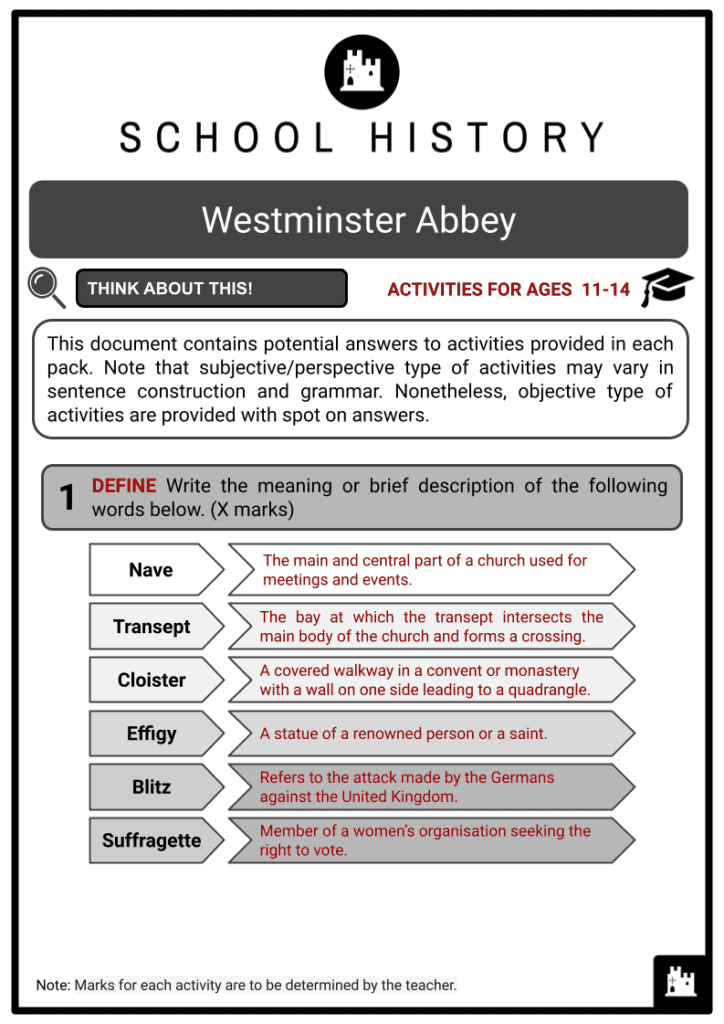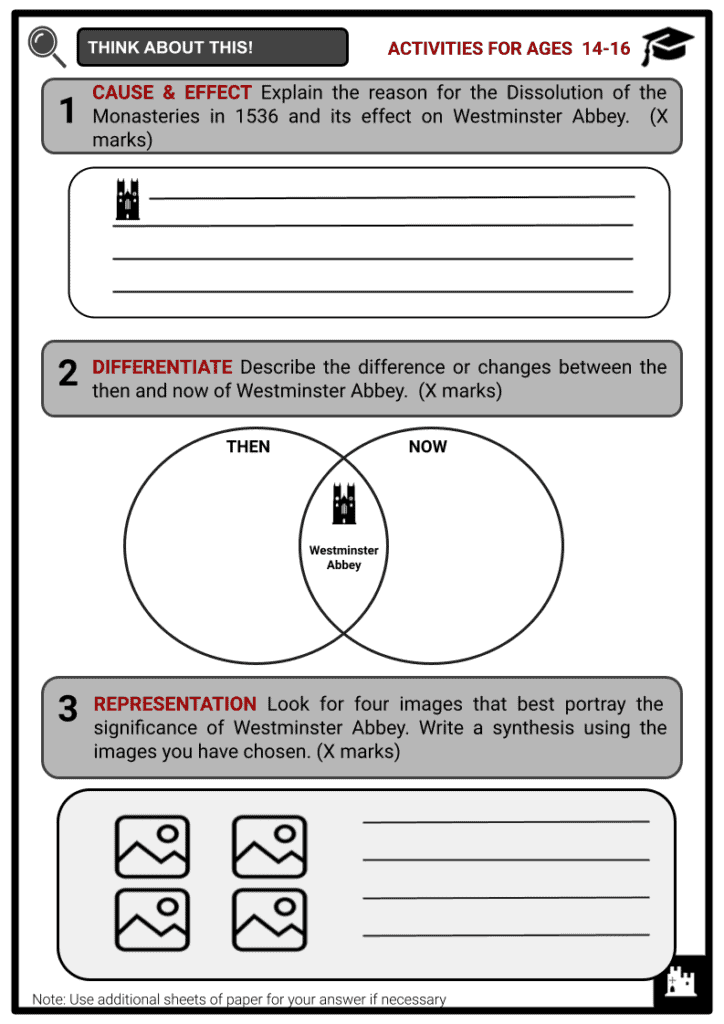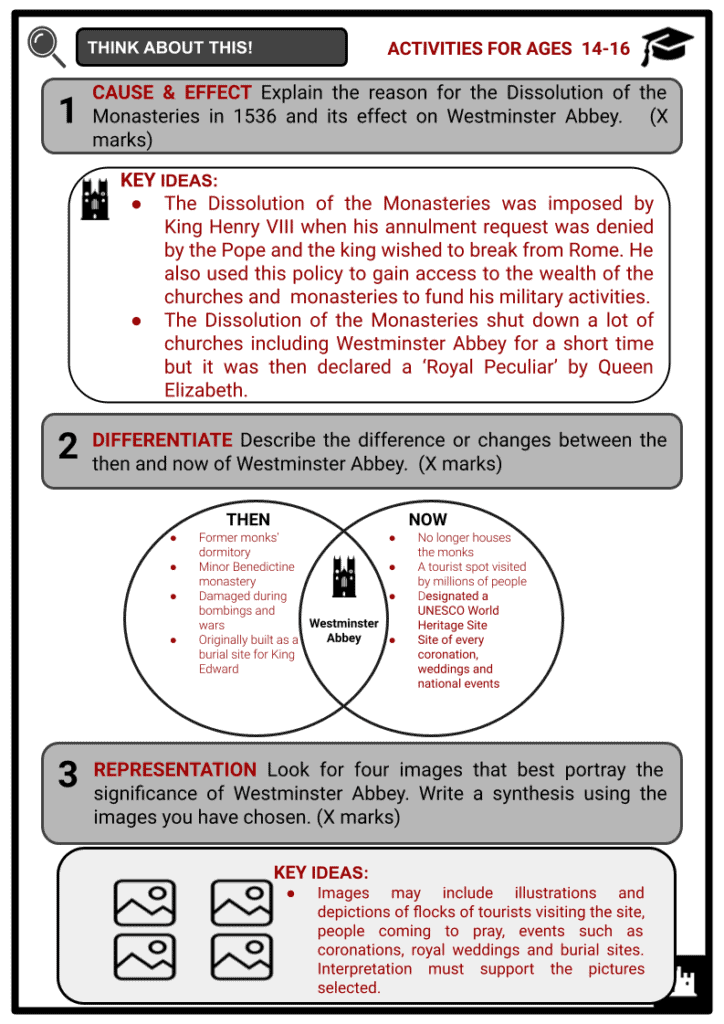Westminster Abbey Worksheets
Do you want to save dozens of hours in time? Get your evenings and weekends back? Be able to teach about the Westminster Abbey to your students?
Our worksheet bundle includes a fact file and printable worksheets and student activities. Perfect for both the classroom and homeschooling!
Summary
- History of Westminster Abbey
- The Abbey in Wartime
- The Church Today
- Inside Westminster Abbey
Key Facts And Information
Let’s find out more about Westminster Abbey!
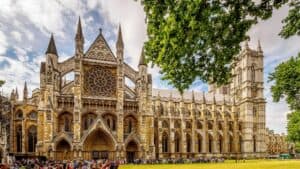
Westminster Abbey is a monumental structure covering 32,000 square feet located in Westminster, Central London. The magnificent and world-famous building has been the site of every coronation since William the Conqueror in 1066. Since then, all royal coronations have taken place at Westminster Abbey. It boasts a rich and dramatic history since it is the burial place of more than 3,300 historical figures.
History of Westminster Abbey
- Legend has it that a young fisherman by the name of Aldrich had a vision of Saint Peter on the banks of the River Thames (then known as Thorney Island), near the current site of Westminster Abbey.
- When Aldrich expressed his vision to others, they all responded favourably. Between the 960s and early 970s, Saint Dunstan and King Edgar established a community of Benedictine monks where they could live and worship in the area.
- In the 1040s, King Edward the Confessor established his royal palace near the monastery. He decided to rebuild a large stone church dedicated to St Peter the Apostle, which was consecrated on 28 December 1065.
- It was the first church in England, called ‘West Minster’, and was built in Romanesque style (Norman).
- King Edward passed away a few days after the completion of the new structure and his body was initially buried in front of the high altar, but it was eventually relocated.
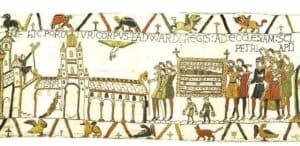
Image depicting St Peter’s Abbey at the time of Edward’s funeral - Among the most important ceremonies that occurred in the abbey during this period was the coronation of William the Conqueror on 25 December 1066.
- King Edward’s Abbey survived for nearly two centuries until King Henry III decided to rebuild the building in the new Gothic architecture.
- Of Edward’s monastery, only the round arches and columns of the undercroft and the Pyx Chamber of the cloisters can be seen today.
The New Abbey Building
- In 1245, Henry III’s builders tore down all of the old building except for the nave and rebuilt it with the present abbey church in the pointed Gothic style of the period. The design and layout were heavily influenced by contemporary French cathedral architecture.
- The new Westminster was made to be a place of worship, a monastery and a place where monarchs could be crowned and buried.
- On 13 October 1269, the new abbey building was consecrated.
- By the time Henry III passed away in 1272, there was just one nave that was completed. The work was put on hold for nearly a century.
- Beginning in the late 1300s, the nave was rebuilt in the same Gothic style under the supervision of architect Henry Yevele, John of Gloucester, and Robert of Beverley.
- It has a high ceiling with pointed arches. The narrow aisles make the central section (the nave) appear taller, longer and thinner than it actually is.
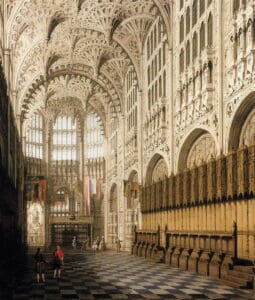
Image depicting the Interior of Henry VII’s Chapel
The Lady Chapel
- The next significant alteration at Westminster Abbey is the construction of the Lady Chapel.
- In 1503, King Henry VII commissioned the construction of this chapel, but it was not completed until 1516, almost six years after his death. The Order of the Bath resides at the Henry VII Lady Chapel, which is dedicated to the Virgin Mary.
The Dissolution and Restoration
- The Dissolution of the Monasteries was a law introduced in 1536 by Henry VIII of England to shut down and confiscate the lands and wealth of all monasteries in England and Wales.
- The Dissolution of the Monasteries was referred to as the suppression of the monasteries. The king disbanded the convents and friaries and expropriated their income to fund his military campaigns.
- Henry began his Reformation of the Church in England and broke off from Catholic Rome mainly because he wanted to annul his marriage to his first wife Catherine of Aragon, and marry Anne Boleyn. However, the Pope refused to grant the annulment.
- The disagreement led Henry to pursue the reformation and present the Act of Supremacy, formally making the English king head of the Church of England. The Dissolution of the Monasteries was eventually passed to abolish all monasteries in his kingdom.
- Following the dissolution of the Westminster diocese, Westminster Abbey became the second church of the Diocese of London. The abbey was then restored during the reign of Queen Mary I, but Elizabeth I revised this when she ascended the throne.
- In 1560, Queen Elizabeth granted Westminster Abbey the title ‘Royal Peculiar’ and made it the Collegiate Church of St Peter, enabling the abbey to function as a church of England, with the exception that it would answer solely to the sovereign and not according to the jurisdiction of bishops and archbishops.
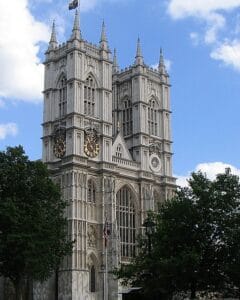
Image depicting the West Towers
The Building of the West Towers
- The western towers were constructed between 1722 and 1745 by Nicholas Hawksmoor and later by his successor John James. The towers are made from Portland stone, and Purbeck marble was used for the walls and the floors of Westminster Abbey.
- During the Victorian renovation in the 19th century, Sir George Gilbert Scott oversaw the reconstruction and refurbishment of the towers.
The Abbey in Wartime
The Bombing in 1914
- Between 1912 and 1914, Great Britain and Ireland suffragettes planned a bombing and arson campaign. The Women’s Social and Political Union initiated the campaign, which was part of their larger effort to get women’s suffrage.
- During the campaign, churches were a particular target, as it was believed that the Church of England was complicit in reinforcing opposition to women’s suffrage.
- On 11 June 1914, they planted a bomb which exploded inside the abbey, and there were 80-100 visitors at that time. The people panicked, but there were no serious injuries. It was also reported that the Coronation Chair was damaged.
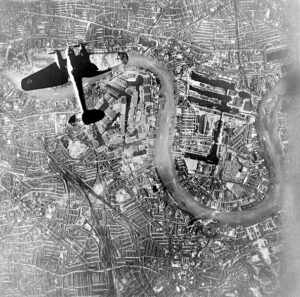
Image depicting a Heinkel He 111 bomber over London
World War II
- The German bombing effort against the United Kingdom during the Second World War in 1940 and 1941 was called the Blitz.
- At the outbreak of the Second World War in 1939, many of the abbey’s treasures were evacuated for safety to country houses.
- The Blitz caused damage to Westminster Abbey on 15 November 1940. On the night of 10/11 May 1941, World War II caused far greater destruction.
- The abbey roof over the north transept and other nearby buildings were bombarded with firebombs.
- While the majority of fires were quickly extinguished, one fire bomb that landed on the lantern roof burnt through the wood and melted the lead, which then dropped into the abbey.
- The ARP (Air Raid Precaution) guards assisted in extinguishing the fires efficiently. A lot of repair work was necessary to fix the abbey after it was devastated during World War II.
The Church Today
- The Westminster Abbey today is still a church dedicated to regular worship and celebrating significant events such as social, political and cultural affairs. However, it no longer houses monks or nuns. It is now one of London’s most popular tourist attractions, seen by over a million visitors annually.

Layout of the present Westminster Abbey - In 1987, the church was designated a UNESCO World Heritage Site in recognition of its significance to British history.
- The abbey was constructed in the shape of a cross, with the transept (the cross portion of a structure) being 203 feet in length and 80 feet in width. The nave measures 166 feet in length and over 71 feet in width, and has a vaulted ceiling that extends up to over 101 feet in height.
Inside Westminster Abbey
- Westminster Abbey is filled with statues, tablets and inscriptions commemorating kings, queens, knights, writers, musicians, scientists, and statesmen. However, not all are buried in the abbey.
- Among the notable people buried there are the poets Chaucer, Tennyson and Browning, as well as the authors Charles Dickens and Rudyard Kipling. Additionally, the tomb of the Unknown Soldier is located in the abbey. There are around 3,300 persons buried in the church and cloisters.
The North Transept
- The Great North Door is the primary entry of Westminster Abbey, where the majority of visitors begin their tour.
- This tower contains the large rose window, the abbey’s ring of ten bells and a one-handed clock.
Poets' Corner
- The Poets’ Corner is one of the most recognisable aspects of Westminster Abbey, located in the eastern aisle of the south transept.
- It was founded in 1400 as the final resting place for Geoffrey Chaucer but has since been developed to accommodate other renowned writers and poets such as William Shakespeare, Charles Dickens and Rudyard Kipling.
- There are currently around one hundred writers and poets memorialised here.
Sanctuary and The Quire
- The Sanctuary is the primary area of the church, where daily religious services and significant royal ceremonies such as coronations, weddings and funerals take place.
- The front of the high altar is a stretch of floor that goes back to 1268 and is notable for its Cosmati work, which consists of an elaborate pattern of colourful inlaid marble on a plain marble floor.
Coronation Chair
- One of the world’s most valuable and famous pieces of furniture in Westminster Abbey is the Coronation Chair kept in St George Chapel.
- The ancient wooden chair has been used at every coronation ceremony since 1066. It is historically known as the St Edward’s Chair or King Edward’s Chair. It includes a sandstone block called the Stone of Scone that the king seized after defeating the Scots at Scone in 1296.
- In total, 39 coronations have taken place in the abbey, the most recent in 1953 of the current monarch, Her Majesty, Queen Elizabeth II.
The Cloisters
- The cloisters date from the 13th to the 15th centuries and were one of the most active areas of Westminster Abbey, where the monks spent a great deal of time.
- They were used mostly for meditation, exercise and as a route to the main monastic facilities.
- In medieval times, the abbot held his annual Maundy on the Thursday of Holy Week in the East Cloister.
- Additionally, there is a memorial fountain in the cloister garth that honours Lancelot Capability Brown, the last of the 18th century’s great landscape architects.
Chapter House
- The Chapter House was built in the late 13th century and was then restored by Sir George Scott in 1872.
- Benedictine monks originally used it for daily discussions, and the room later served as the meeting spot for the King’s Great Council in 1257 and Parliament from the 14th to 16th centuries.
- The Chapter House is a beautiful example of Gothic architecture, with a vaulted ceiling supported by a thin central column.
Royal Tombs
- Beginning with King Edward the Confessor, 30 rulers and queens are entombed at Westminster Abbey. A splendid shrine dedicated to him stands immediately beyond the high altar.
- The tomb of Henry III, who constructed the abbey, is located nearby. Queen Elizabeth I and her half-sister, Queen Mary I, are buried in the north aisle of the Lady Chapel, while Charles II, Queen Anne, Queen Mary II and King William III are buried in a crypt in the south aisle.
Image Sources
- https://www.visitlondon.com/things-to-do/place/610825-westminster-abbey
- https://en.wikipedia.org/wiki/Westminster_Abbey#1042:_Edward_the_Confessor_starts_rebuilding_St_Peter's_Abbey
- https://en.wikipedia.org/wiki/Henry_VII_Chapel
- https://en.wikipedia.org/wiki/File:Western_Towers,_Westminster_Abbey.jpg
- https://en.wikipedia.org/wiki/The_Blitz
- https://commons.wikimedia.org/wiki/File:Layout_Of_Westminster_Abby.svg

